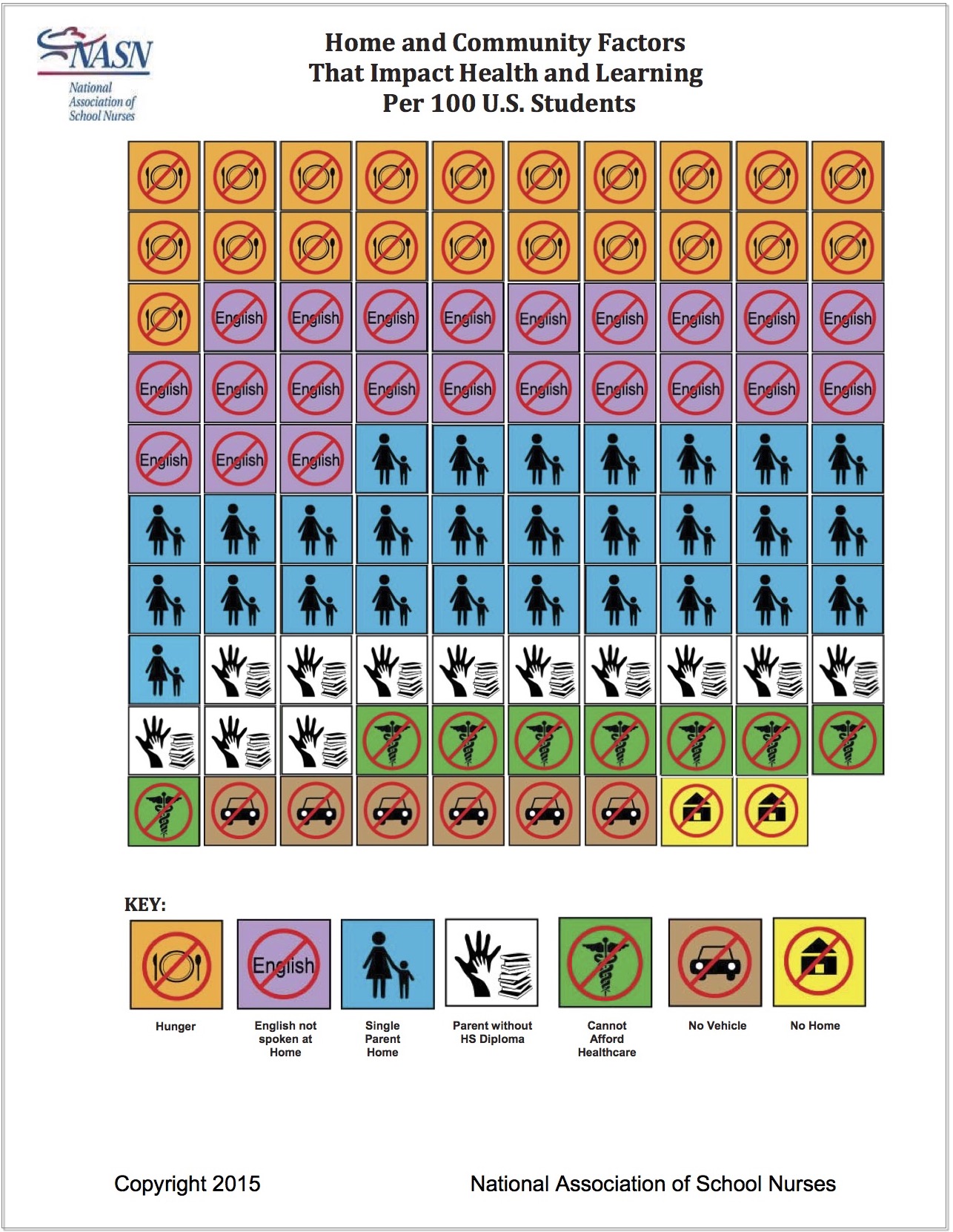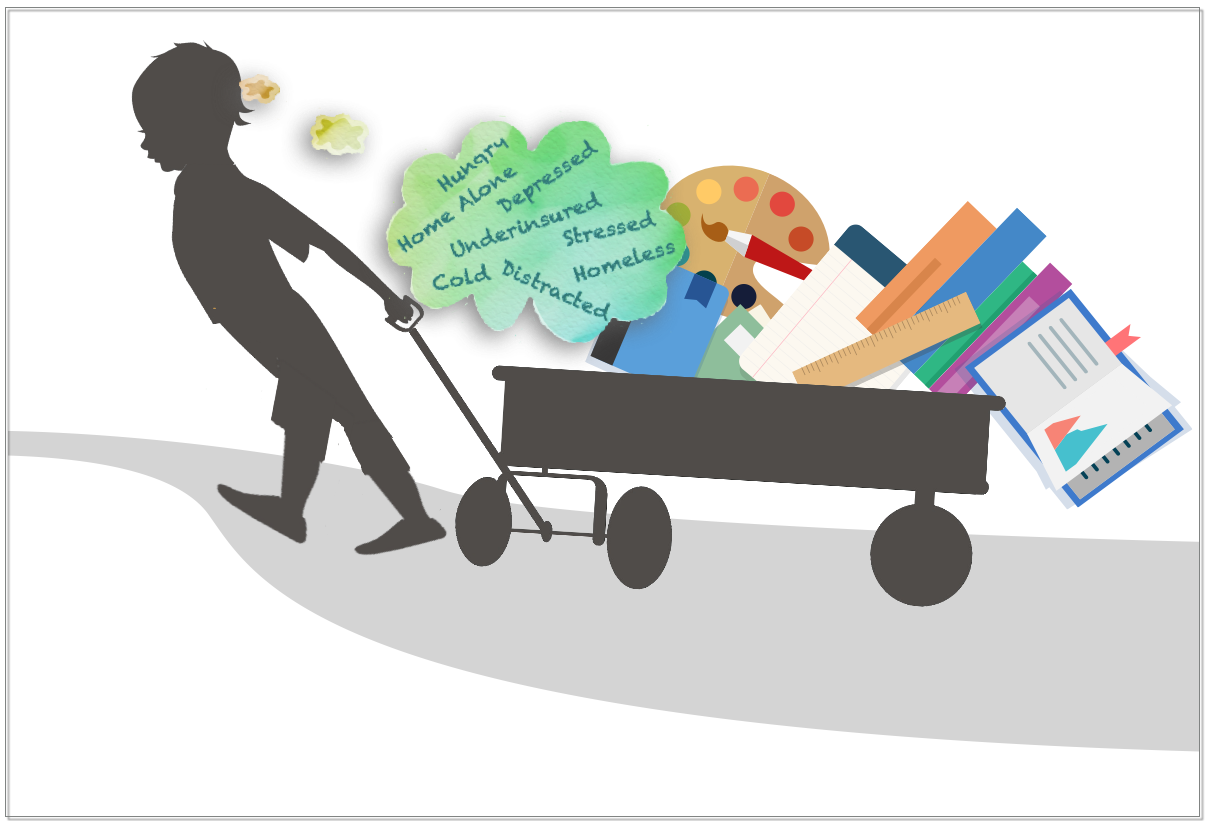School Nurses: How Social Determinants Impact Their Work
“School nurses sometimes are like the mom away from home. We fix glasses, provide ties for pants that are too big, deal with hygiene issues…we deal with things that are more nurturing in nature rather than health related.”
— Missouri School Nurse
In the previous article in this series, we shared detailed data and stories focused on the chronic medical conditions, complex treatments, and medications and that are part of the daily routine for school nurses. Now, we turn our attention to socioeconomic factors that may create additional barriers to being healthy and learning, also known as social determinants of health. School nurses, are often the first point of contact for children facing social and emotional barriers to learning because they show up as physical symptoms, often headaches and stomach aches.
In a recent summary, prepared by the National Association of School Nurses, they identified 7 factors having a negative impact on child health and learning at the national level. These factors hinder children’s capacity to fully participate in school activities and diminish the benefits of their academic experience.

The Missouri KIDS COUNT team individually interviewed school nurses from 13 Missouri school districts. We asked each of them to identify the challenges they face as school nurses to provide a more complete account of what it looks like inside our schools from their perspective. Every one of the school nurses interviewed mentioned unmet basic needs as the main challenge they have to work with when caring for children from disadvantaged families. While reading their insights and observations below, we invite you to consider how school nurses are integral and necessary partners to teachers, parents and administrators.
Relieving Hunger
“We are glad to have a Food Back Pack Program in which students are given food to take home for the weekend. This program is sponsored by our local Christian Service Center. When our school moved to a four-day week, we were concerned the students, who relied on the Back Pack Program, wouldn’t have sufficient food for the longer weekend. Fortunately, our community stepped forward and it is providing food for the extra day. Without the Back Pack Program these children may not get enough food to prevent hunger over the week-end.”
—Kathy Hadlock Miller R II School District
Helping Overwhelmed Parents
“We have occasional kindergarten and first grade students who get ready for school by themselves. Their parents work during the night and sometimes it is difficult for them to get up in the morning. These kids come in to my office daily for ‘checks’, by checks I mean that I make sure that their hands are clean, their hair is combed, that they have eaten breakfast, and that they have the appropriate clothing. It is not that these families are neglectful, they just need a little help now and then”.
—Stacey Whitney Carl Junction R-1 School District
Finding a Stable Home
“An unaccompanied high school student had an ankle injury that required surgery. We (school nurses) took him to his doctor appointments before the surgery, but he needed someone to take care of him for a few weeks after the surgery as he was not allowed to put any weight on his leg. The social worker managed to get the person he had been staying with to care for him post-surgery. We were able to come up with a pair of crutches and a temporary wheel chair to get him through his surgery recovery. We helped him go through surgery, but without someone to volunteer to care for him, we would have been in a bind.”
— Pat SturgesSedalia 200 School District
Providing Emotional Support
“So many families don’t have resources, transportation, experiencing substance abuse, mental illness. Over the years, a lot of what I do has become more like social work and case managing. I see children who experience chronic turmoil in their homes, at night, which affects them dramatically during the day when they are in school. Some days I may be the friendliest face they see. But there is a lot I can’t fix”.
— Angela Huffman Grundy R-V, Pleasant View, Laredo
Transportation Difficulties
“Sometimes it is difficult to reach parents when we need them. Parents often have a hard time getting off work to pick up their sick child. They need to work to afford caring for their children. Other times parents can’t pick up their kids because they don’t have transportation available. Transportation is often a problem.”
—Missouri School Nurse
Challenges in Rural Communities
“We are very rural, there is no hospital, the nearest is 40 miles away. There is one small pharmacy, 2 clinics, no doctor in the county, nurse practitioners staff the clinics, no dentist for new patients. Any referrals have to travel at least 40 minutes. A lot of parents send their kids to school when the kids are sick because they know the nurse will do the first medical assessment determining whether the child must be taken to a clinic or to the hospital, both of which mean time away from work, travel, etc. Children spend lots of time in the nurse office. Lots of families have no income or only disability income, when someone needs to be called, often the parents are not available. We track the health insurance status of children and our children are 52% are on Medicaid, 15% have no insurance”.
— Kathy Palmer Knox County R-1 School District
School Nurse Observations about Barriers to Care
We heard from every nurse we interviewed about barriers to care for children, beyond the school doors. They describe the lack of providers – pediatricians, dentists, specialists in their communities. In rural districts, parents have to drive very long distances to take their child to a doctor. Often children are taken the Emergency Room of the nearest hospital because the ER is the most accessible. We also heard all too frequently the serious problem with oral health – many children in Pre-K with dental cavities and many children of all ages complaining of teeth hurting.

School nurses do a lot of screenings, but find that parents often cannot follow up from the vision and hearing screenings with the purchase of eyeglasses or hearing devices that are necessities for their school work. Once again, school nurses turn to their community resources for help. Finally, every school nurse interviewed identified health insurance as an ongoing challenge. Without health insurance, or insurance with unaffordable deductibles and copays, many children remain under-treated and without the health interventions and prevention screenings they need. The uninsured/underinsured status also results in school nurses spending more of their time doing basic health education with these children and families.
Fostering Meaningful Community Connections
School nurses around Missouri, in rural and urban school districts, understand that coordinated systems of support are necessary to address and eliminate the non-medical barriers to children’s attendance and meaningful engagement in school. They are experts in identifying and connecting to local and regional resources, philanthropies and child serving agencies to meet the social and economic needs of children and their families. Every nurse we talked with expressed deep gratitude for the availability of resources, the generosity of the community and the strong support they receive from their superintendent. We heard from nurses who developed their resource networks over many years; nurses with 23 years tenure, 19 years, and 16 years who know exactly who to call and where to go to meet a child’s needs. But developing this network and identifying the right resources takes time—time away from the non-acute health care work school nurses are trained to do—health education, immunizations, environmental health, etc. For schools with social workers, the school nurse has a strong partner to turn to.
Summary
School nurses are a vital resource for children and families struggling with the negative impact of social determinants. Although not in their immediate job description, school nurses often wear several different hats, including social worker and counselor, to help children cope with non-medical factors affecting their learning. The school nurses that the Missouri KIDS COUNT team interviewed identified unmet basic needs as a challenge they have to help cope with every day. School nurses can be an effective ally in improving the conditions of children from disadvantaged backgrounds given their unique position as first responders. In order for school nurses to help address the negative impact of social determinants of health, however, it is necessary to provide them with specialized training and support staff to lighten the heavy workload they already carry.
Coming Up Next…
In the final article in the school nurse series, we will share with you the landscape of school nurses and school health service staff in Missouri. We will tell you the success story that is the State School Nurse Consultant and the reason why Missouri is considered a leader in school nursing. In addition, we will describe the resources that school nurses consider are needed for them to be more effective, and issue a call to action to communities, agencies, funders, healthcare institutions, and families to support school nurses—get to know them, thank them, include them, and help them give our children the best possible school experience.
Suggested Citation
Hines, L., Cole, M., Martinez, M. M. & Kauffman. M. (2016, February). School Nurses – How Social Determinants Impact Their Work. The Family and Community Trust (FACT)—Missouri KIDS COUNT. Available at: http://mokidscount.org/wp-content/uploads/2016/01/School-Nurses-2_01.11.16_Web-1.pdf
Acknowledgments: We would thank everyone who contributed to the article, whether through interviews or stories. We are grateful to the University of Missouri Center for Family Policy and Research for their expertise.
Funding for Missouri KIDS COUNT is generously provided by the Annie E. Casey Foundation.
February 3, 2016




